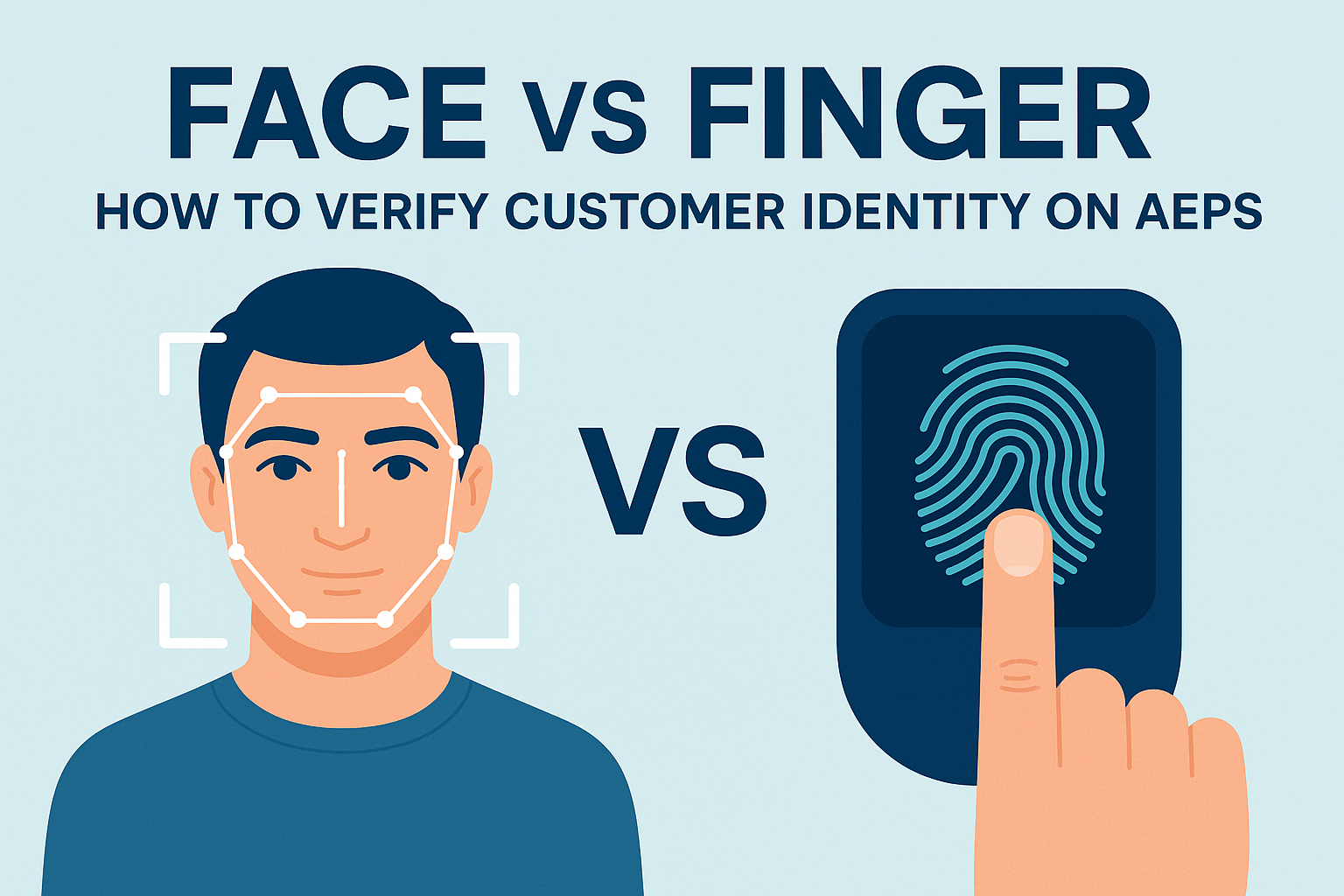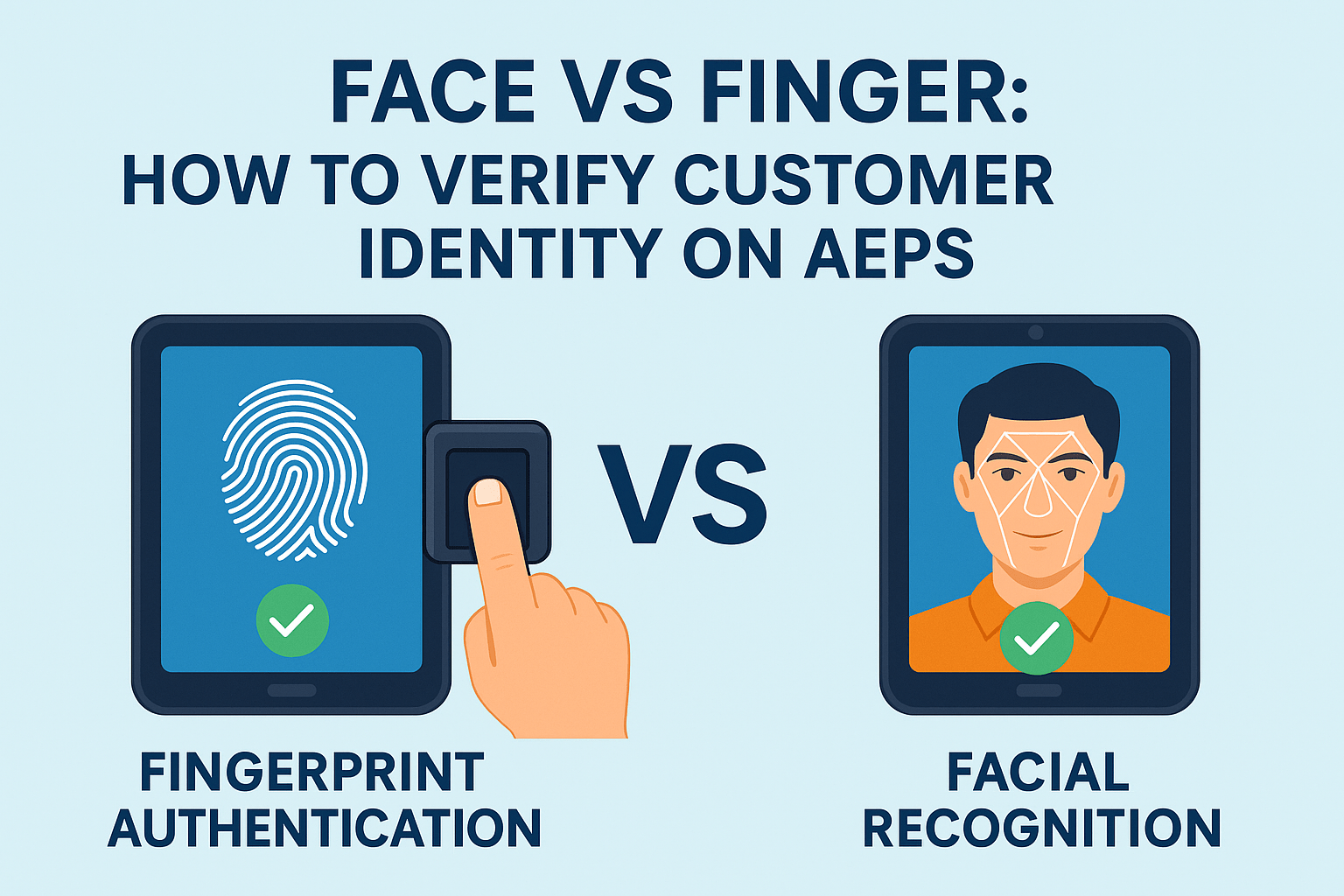How to verify customer identity on AEPS? This is a critical question for banks, payment service providers, and customers using Aadhaar-enabled payment systems (Face vs Finger). With fraud and identity theft on the rise, secure authentication is more important than ever. AEPS primarily uses biometric verification—either fingerprint scanning or facial recognition—to confirm a user’s identity. But which method is more reliable, faster, and secure?
In this in-depth guide, we’ll break down how AEPS identity verification works, compare face vs. fingerprint authentication, and help you understand the best practices for secure transactions.
How Does AEPS Identity Verification Work?
AEPS (Aadhaar Enabled Payment System) is a bank-led model that allows transactions using Aadhaar authentication. When a customer initiates a transaction (like cash withdrawal, balance inquiry, or fund transfer), their identity is verified using:
-
Aadhaar Number – Unique 12-digit ID linked to biometric data.
-
Biometric Authentication – Either fingerprint or iris/face scan.
-
Bank IIN (Institution Identification Number) – Identifies the customer’s bank.
The system matches the biometric input with the data stored in the UIDAI (Unique Identification Authority of India) database. If it matches, the transaction is approved.
Fingerprint Authentication in AEPS
How It Works
Fingerprint verification is the most common method for AEPS identity verification. The customer places their finger on a biometric scanner, which captures ridge patterns and matches them against UIDAI records.
Pros of Fingerprint Verification
✅ High Accuracy – Fingerprint patterns are unique, making it difficult to fake.
✅ Fast Processing – Takes just a few seconds for verification.
✅ Widely Adopted – Most AEPS devices support fingerprint scanning.
Cons of Fingerprint Verification
❌ Wear & Tear Issues – Manual laborers or elderly users may have worn-out fingerprints.
❌ Hygiene Concerns – Shared scanners can spread germs.
❌ Spoofing Risks – Advanced fraudsters can replicate fingerprints using silicone molds.
Best Use Cases
-
Rural areas where facial recognition tech is limited.
-
Quick transactions like cash withdrawals or mini-ATM services.

Facial Recognition in AEPS
How It Works
Facial recognition uses a camera to scan the user’s face and matches it against UIDAI’s database. The system analyzes facial features like distance between eyes, nose shape, and jawline.
Pros of Facial Recognition
✅ Contactless Authentication – More hygienic than fingerprint scanners.
✅ Works Despite Fingerprint Damage – Useful for users with unreadable fingerprints.
✅ Harder to Spoof – Advanced liveness detection prevents photo/video fraud.
Cons of Facial Recognition
❌ Lighting & Angle Sensitivity – Poor lighting or incorrect angles can cause failures.
❌ Slower in Some Cases – May take longer than fingerprint scans.
❌ Privacy Concerns – Some users are uncomfortable with facial data storage.
Best Use Cases
-
Urban areas with better internet and device infrastructure.
-
Users who struggle with fingerprint authentication.
Face vs. Finger: Which is Better for AEPS Verification?
| Factor | Fingerprint | Facial Recognition |
|---|---|---|
| Accuracy | High | Moderate to High |
| Speed | Very Fast | Slightly Slower |
| Hygiene | Low | High (Contactless) |
| Fraud Resistance | Moderate | High (With Liveness Check) |
| Accessibility | Issues for Worn-Out Fingers | Works for Most Users |
Verdict:
-
Fingerprint scanning is better for speed and rural adoption.
-
Facial recognition is better for hygiene and users with fingerprint issues.
For maximum security, some AEPS services now use multi-factor authentication (MFA), combining fingerprint + face or OTP for high-value transactions.

Best Practices for Secure AEPS Verification
-
Use Certified Biometric Devices – Ensure scanners meet UIDAI standards.
-
Enable Liveness Detection – Prevents spoofing with photos or fake fingerprints.
-
Educate Customers – Train users on proper scanning techniques.
-
Monitor Transactions – Flag suspicious activity in real-time.
Frequently Asked Questions (FAQs)
Q1. Can AEPS work without biometric authentication?
No, AEPS mandates biometric (fingerprint/face) or OTP-based verification for security.
Q2. What if my fingerprint is not recognized?
You can switch to facial recognition or visit your bank branch for Aadhaar updates.
Q3. Is facial recognition safer than fingerprints?
It depends—facial recognition with liveness checks is harder to spoof, but fingerprinting is more established.
Q4. Can someone misuse my biometric data?
UIDAI stores encrypted biometrics, making it extremely difficult to misuse.
Conclusion
How to verify customer identity on AEPS? The answer depends on your needs—fingerprint scanning is faster and more widely used, while facial recognition offers hygiene and accessibility benefits. As fraud techniques evolve, AEPS providers must adopt advanced security measures like multi-factor authentication to stay ahead.
For businesses, choosing the right biometric method improves customer trust and reduces fraud. For users, understanding these options ensures smoother, more secure transactions.
Disclaimer
This post is for educational purposes only. If you have any concerns regarding content ownership or DMCA-related issues, please refer to our DMCA page for guidance on post removal. Always verify the latest AEPS guidelines from official UIDAI or banking sources before making financial decisions.
